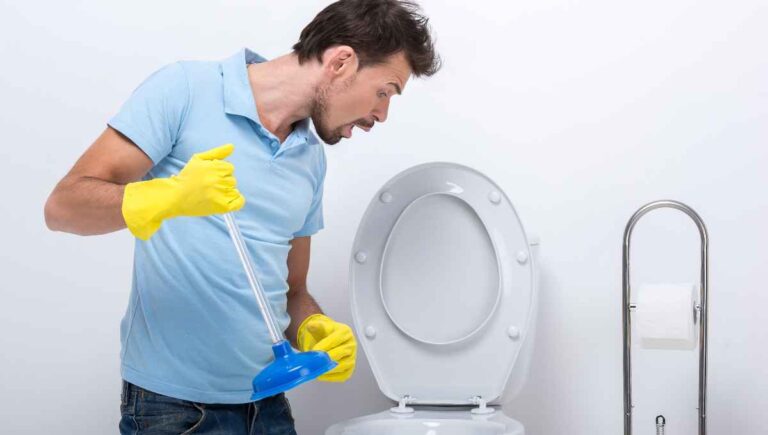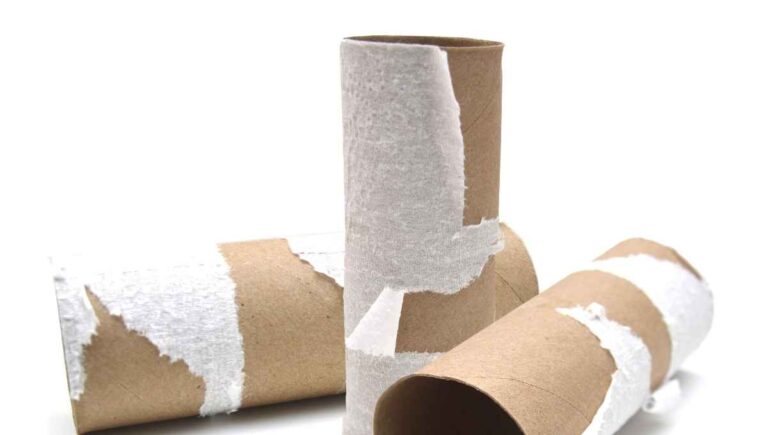Are Toilet Lid Covers Sanitary? (What to Look Out For)

Sometimes we struggle with making our bathroom aesthetically pleasing, and more often than not, we consider things like toilet lid covers to help us achieve our decorative goals. But are toilet lid covers sanitary, or do they trap germs and become unsanitary over time?
Toilet lid covers can become unsanitary if one doesn’t wash them well or regularly. To avoid having a toilet lid cover become unsanitary, it’s best to maintain a solid cleaning schedule that can guarantee the overall sanitation of the bathroom.
Luckily, there are safe and sanitary options that you can consider if you are looking for the cleanest option. Whether you own a toilet lid cover or not, it’s best to make sure that we make the right choices regarding safety concerns.
Therefore, this article will discuss the purpose of a toilet lid cover, keeping them clean, and whether you should consider getting one.
This post contains affiliate links. This means Household Blogger may earn a commission should you make a purchase using any of our links. Please refer to our full affiliate disclosure policy for full details.
Here’s a Quick Pro Tip!
The sanitation of your toilet lid cover will mostly depend on how you maintain it, the fabric it’s made with, and other contributing factors that may occur while using the toilet.
Luckily, there are safe and sanitary options that you can consider if you are looking for the cleanest option.
We think that you might like these:
Memory Foam Bathroom Set – For a clean yet sharper look.
Your Granny’s Favorite Lid Cover – Surprise her on Mother’s Day.
How Toilet Lid Covers Work
To help you determine if you need a toilet lid cover, we’re going to explain its primary purpose and why you might want to start using one.
What Is the Purpose of a Toilet Lid Cover?
Toilet lid covers provide a sense of style and décor to the bathroom that is pleasing to the human eye. Yet, most people find it useless because it takes more cleaning. From this, you can deduce that they are losing popularity amongst people.
A toilet lid cover aims to give style to a bathroom, but that’s its only use.
There is no true evidence that proves that it works to keep your bathroom more hygienic, so you shouldn’t think of it that way unless it’s something that keeps your mental peace intact.
Are Toilet Lid Covers Solely Aesthetic?
Even though toilet lid covers are found to be interesting when it comes to styling a bathroom, they only provide aesthetic pleasure. They do not provide any true protection for your toilet lid. Hence, many people prefer not to use them.
Toilet lid covers aren’t common in modern homes.
Since toilet lid covers only provide a sense of style to the restroom and not anything else of value, we must conclude that they could not be considered truly necessary.
Do Toilet Lid Covers Protect the Toilet Lid?
Toilet lid covers, in essence, cover the toilet lid. The toilet lid’s function is to keep the germs and other nasty stuff within the toilet bowl, but using a toilet lid cover is only a matter of aesthetics. It does not contribute positively or negatively to this purpose.
Many toilet lid cover owners claim that using a toilet lid cover can ease the cleaning process of the toilet lid itself.
This means that they only need to clean the toilet lid cover and not necessarily spend effort on cleaning the toilet lid itself.
Are Toilet Lid Covers Outdated?
It’s rare to find toilet lid covers in modern homes because people are more conscious about the natural environment that surrounds the bathroom. Generally, most prefer minimalistic décor to keep themselves away from interacting with a toilet’s ambiance.
There are multiple reasons why today’s modern homes won’t have a toilet lid cover, though this mainly goes around the need for perfect hygiene.
Of course, we can’t deny that many people go against the norm and prefer to keep their bathrooms stylish.
Of course, the latter keeps everything in their bathroom clean and spotless, so you shouldn’t think less of them just because this isn’t something you wouldn’t use in your house.
The Hygiene Behind Toilet Lid Covers
Now that you know what the purpose of a toilet lid cover is, you must understand the hygiene behind them.
Are Toilet Lid Covers Sanitary?
Toilet seat covers are as sanitary as your bathroom habits. If you want a sanitary cover, you can make it happen. You’ll have to maintain the fabric it’s made with and clean any other contributing factors that may occur while using the toilet.
Most people find toilet lid covers to be disgusting because they can trap the bacteria and humidity of the environment, so they’re perceived as a general focus of infection, according to the National Library of Medicine.
Though, there is no true need to be concerned as the cover does not make a significant difference in bacteria levels.
You might also enjoy our post on Should You Flush After Peeing?
Do Toilet Lid Covers Harbor Germs?
Toilet lid covers don’t harbor germs on their own, but they attain it from the environment after using a bathroom. Therefore, it’s essential to keep them clean regularly since this helps prevent the unpleasantness of having an unsanitary bathroom.
Toilet lid covers can get germs from the bathroom environment, so if you don’t keep them clean regularly, it can backfire and attract unwanted guests.
Make sure to keep this in mind if you ever consider styling your bathroom to its maximum potential.
Do Toilet Lid Covers Carry a Lot of Bacteria?
Toilet lid covers only carry the bacteria that they get from the bathroom’s general environment, but the number of bacteria may vary depending on several factors. For example, it’s more evident when you don’t clean your bathroom regularly.
If you consider buying a toilet lid cover, you must keep in mind all the cleaning processes you need to do to maintain a safe environment in your bathroom.
You should be able to make your best effort to keep it all clean and avoid further issues.
What Type of Bacteria Can Be Found on a Toilet Lid Cover?
Toilet lid covers are often made from diverse fabrics, so it’s common for them to gain bacteria from the humidity they may harbor, such as human skin bacteria. However, the latter does not pose a real threat to overall human health.
The bacteria found on a toilet lid cover is not really something to be panicked about. However, there is no doubt that preventative measures should still be taken to avoid any casualties.
Should I Use a Toilet Lid Cover?
Whether you should use a toilet lid cover or not may depend on several factors, but it’s mostly about your preference. Many prefer not to use them because they don’t last as long as they should, since they stain and get dirty easily.
If you like the idea of a fully-decorated bathroom, you shouldn’t hesitate to get a toilet lid cover set. But if you’re looking for a more sanitary option, then this wouldn’t be good for you.
What Is the Most Sanitary Toilet Lid Cover?
The sanitation of a toilet lid cover solely depends on you. There is no definitive answer for which one is better in these terms since they are mostly made from fabrics, and these tend to catch anything that’s floating in the environment of any room.
You should be able to keep your toilet lid cover as clean as possible, especially knowing now how sensitive they are to the bacteria and other things that may be floating around your bathroom, which is often a gateway for insanitation.
What Are the Different Types of Toilet Lid Covers?
Toilet lid covers come in various forms, shades, sizes, and patterns. They are made with different fabrics, and some are more comfortable than others. However, even though they can be made from multiple fabrics, there is not much variety.
You can find toilet lid covers made from cotton, spandex, or nylon. The one you choose will obviously match your preference and the color scheme of your bathroom.
Are Wooden Toilet Lid Covers More Sanitary Than Fabric Ones?
Even though toilet lid covers come in different materials, there are none made from wood. However, if you are referring to a wooden toilet seat, then the answer is much different. Wooden toilet seats are more likely to retain moisture, which is inconvenient.
Although wooden toilet seats are often more aesthetically pleasing, they are prone to rot over time, and they wouldn’t last as long as you would like them to.
Are There Anti-bacterial Toilet Lid Covers?
The best thing about toilet seat covers is that they come in diverse materials that are convenient for any type of user. For someone who is looking to keep a sanitized bathroom, the best toilet lid cover they could choose is made from memory foam, due to its antibacterial properties.
Memory foam toilet lid covers offer a variety of benefits, from being easy to clean and even being scratch-resistant.
So if you are looking to style your bathroom but are afraid of uncleanliness, these toilet lid covers are your go-to.
How To Keep Toilet Lid Covers Clean
Now that you know about the hygiene behind toilet lid covers, it’s time to learn the best ways to keep them clean.
How Often Should I Clean a Toilet Lid Cover?
Toilet lid covers should undergo maintenance often to avoid them becoming unsanitary. It’s best if you try to wash it at least once a week and keep it disinfected each day to avoid germs and other things from staying in them for too long.
Washing a toilet lid cover isn’t a hard task, and there are many ways to do it.
However, you must make sure to consider the type of material it’s made with so that you don’t make a mistake when choosing the detergent or fabric softener that you can apply.
What Is the Best Way to Clean a Toilet Lid Cover?
Typically, a washing machine is the best way to clean a toilet lid cover. Of course, the type of cleaning a toilet lid cover needs depends on the type of dirt that you’re trying to get rid of. If you’re only following your cleaning routine, then a washing machine can be enough to clean it. Remember to avoid putting in fabrics that may shrink.
The fabrics, the type of stain or dirt, and the type of washing machine that you have are factors that you must consider before putting a toilet lid cover inside of the washing machine.
If you find that there is a specific stain that you can’t get rid of, then washing it by hand is better.
For example, if you own a toilet lid cover like this one made from cotton fabrics and is a light color, but they’re stained, you might need to apply hydrogen peroxide to the stain.
Can I Put a Toilet Lid Cover in a Washing Machine?
Putting a toilet lid cover in a washing machine is often convenient for following a weekly cleaning routine. Preventing your toilet lid cover from retaining germs for too long is essential, but you should consider other ways if it has stubborn stains.
There should be no problem in washing your toilet lid cover using a washing machine, but you must keep in mind that a washing machine doesn’t always get rid of all the stains that your toilet lid cover may get.
Should I Use Cold or Hot Water to Clean Toilet Lid Cover?
Most toilet lid covers require a person only to wash them with cold water. These instructions often come with the cover itself, and it’s necessary to follow them in order to avoid damaging it. And, you must be careful when getting rid of tough stains.
Suppose any accidents occur while using the bathroom.
In that case, it’s best to take the lid cover off immediately and throw it into a washing machine with detergent and fabric softener, the latter being helpful to get rid of any lingering smell.
Can I Vacuum a Toilet Lid Cover?
Vacuums are designed to collect dust, dirt, and debris. Still, they don’t always penetrate deep into the rug or toiled lid cover enough to eliminate the potential bacteria they may have. Thus, it’s better to clean it manually or use a washing machine.
You can try to vacuum your toilet lid cover, but it won’t guarantee that all the other germs and unsanitary stuff truly get out of it.
Even though it’s not something to be concerned about on a health level, you should always strive to keep things clean and sanitary.
You might also enjoy our post on What To Do If You’re Splashed With Toilet Water
Related Questions
Are Fitted Toilet Floor Mats Sanitary?
Toilet floor mats tend to give an extra push to the aesthetics of your bathroom. They are designed specifically to avoid having a bathroom with unsanitary conditions, as they prevent humidity from remaining around your bathroom.
Having toilet floor mats will prevent you from having bad odors, humidity, and other unsanitary conditions roaming around your bathroom.
They’re made to keep your bathroom sanitary and not the other way around. Of course, it should undergo regular washing to avoid staining or damage from overuse.
And the same rules for washing toilet lid covers apply to toilet floor mats.
Is It Sanitary to Put a Cover on My Toilet Tank?
Having a tank cover can help keep your bathroom sanitary. Toilet tank covers are often made of soft fabrics like cotton, spandex, or nylon. However, they can also come made of wood and other hard materials, which can be very convenient if you want a more sanitary option.
The cover of a toilet tank is not that exposed to the things that roam around a bathroom after using a toilet, so it shouldn’t be that unsanitary or hard to clean.
Of course, if you have a fabric toilet tank cover, you might need to wash it often to avoid stains and other stuff from adhering to the fabric.
It is complicated to use because sometimes there may be dust under it, and often you would need to remove the cover to clean the tank and then put it back.
In addition, if you need to repair your tank, it could serve as an obstruction rather than a helpful thing.
Final Thoughts
Most of the sanitation of a toilet lid cover is more dependent on the person who owns it rather than the object itself. The best way to keep them sanitary is to have them washed regularly.
In case of harsh or stubborn stains, you should look out for the type of stain it is and whether it’s safe for your washing machine or not.
Yet, some stains don’t come out if they’re put under certain conditions, so it’s best to check those out before proceeding.
Even though toilet lid covers may seem cute, the truth is that over time they will be something that will make you spend more time cleaning.
Yet, this doesn’t mean that you shouldn’t use it. Instead, if you decide to use them, you should do so responsibly.









